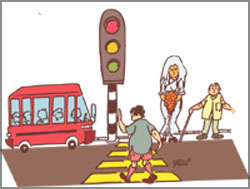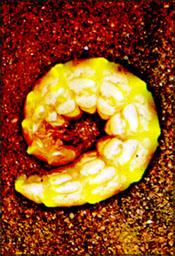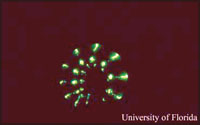|
observer |
|
|
|
|
|
OTHER LINKS |

|

|

|
|
What the colours sayStop says the red light, Go says the green, Change says the amber one Blinking in between. This is a rhyme children in many urban pre-schools learn. It is not just a nursery rhyme like 'Baa Baa Black Sheep' or 'Jack and Jill.' It tells us about an important road rule, something we should know and follow. There are four more lines to the rhyme: This is what they say, This is what they mean, We all must obey Even the Queen. The different colours of the lights tell vehicles when to stop and when to go. When a man's figure appears in green, pedestrians can cross the road. They shouldn't, if the figure of the man is red.
Have you ever given any thought to this - how colours are used to communicate, to give some information, to make something known? Nothing is written. Colours say it all, without one word being written. Red signals danger, or obstacles in the way. Green says all is clear. If you travel by train, you would have seen the guard with two flags in his hand; one is red, the other is green. The engine driver can start moving the train only after the guard waves the green flag. If there is another train coming on the same line, or there is some obstacle, he will hold up the red flag. Look at your calendar. The word Sunday and the days that fall on Sunday are in red; the rest, except public holidays are in black. This is to tell you at a glance, what the public holidays are. While the red flag tells of danger, the white flag is a sign of surrender. During a battle, if one side wants to giveup fighting, before they are defeated, how is this communicated to the enemy? They will wave or unfurl a white flag and the enemy will know that this side is surrendering. A ship flies a yellow flag when someone on the ship has an infectious disease or may have one. Blue Peter is also a flag - a blue flag with a white square in the centre is flown to show that the ship is about to start. The White Ensign is the flag of the British Royal Navy. The White Cane is the symbol of the blind. Blind people carry a white cane to tell others that they are blind; and people on public roads will move aside and let them pass. Among Christians, white is the traditional colour of the bridal dress. Sinhala brides have adopted this custom from our foreign rulers, but Hindu brides will never wear white. White is associated with purity and spirituality. Hence, Buddhists usually wear white when going to temple, and when participating in religious ceremonies like pirith. Those observing ata sil, the eight precepts, on poya days, wear white to indicate that they have retreated from lay-life for that day. Black is the colour of mourning among Catholics and Protestants, but not among the royalty in Britain. When in mourning, the Royal women are in light purple. In Sri Lanka, Catholics and Christians used to wear full black when in mourning for a family member. White is now the common colour for mourning. Black or white flags across the road indicate a funeral house - white flags if the deceased is a Buddhist and black when the deceased is a Catholic or Christian. A black belt is worn by a person who has reached the highest rank in Judo and Karate. The black belt is therefore a status symbol in these martial arts (fighting sports). In football, a yellow card is shown by the referee to a player as a warning about bad behaviour in the playing field; if a red card is shown, the player has to leave the field. A strip of yellow lines painted across the road tells pedestrians "cross here," but few obey the rule. This yellow line is also called 'Zebra Crossing' because the yellow lines on the black road surface resemble a zebra's skin. Do you know the meaning of the other white and yellow lines painted on the road? You are familiar with the red boxes at post offices, for posting letters. There are pillar- boxes, about five feet high and painted red, on roadsides for posting letters. The big post offices have blue boxes too and there are blue pillar boxes by roadsides. These blue boxes are for air-mail letters only. In the city of Colombo, there are green pillar-boxes alongside the red and blue. These green pillar-boxes are for letters posted to Colombo addresses only. In Sri Lanka, political parties have their special colours - SLFP blue, UNP green. The red flag has been the international flag of the Socialists from the time of the Russian revolution. So red is the colour of our Socialist parties from the time these parties, Lanka Sama Samaja Party and the Communist Party were formed. In Britain, there is a political party that calls itself the Green Party, not because the party colour is green. The aim of this party is the protection of the environment. Green has become a synonym (a word with the same or nearly same meaning) for environment. Little trains that glow in the darkOn a quiet evening in rural Brazil, a tiny 'train' emerges from beneath the forest litter. Two red "headlights"
light its Path and 11 pairs of yellow-green lanterns illuminate its sides. To be sure, this is no ordinary train. Rather, it is a 70-millimetre-long larva of the Phengodidae family of beetles, found in North and South America. Because females, which retain their larval form, resemble internally illuminated railway cars, they are often called railroad worms. Brazilian country folk call them little trains. During the day, the dull-brown larva is hard to spot. But at night, it advertises its
presence with its amazing array of lights. These are energised by the organic substance, oxides, to produce cold light. The colours of the light include red, orange, yellow and green. The red headlights glow almost constantly - but not the yellow-green lateral lights. Research suggests that the headlights help the larva to find millipedes, its favourite prey, whereas the sidelights seem to discourage predators, such as ants, frogs, and spiders. In effect, the glow says: "I'm
unpalatable. Go away!" Accordingly, the sidelamps light up when the larva senses a potential predator. They also shine when it attacks millipedes and when the female is curled around her eggs. Under normal circumstances, the sidelights build up to peak intensity and then darken - all within a few seconds - repeating the cycle as often as necessary. |















